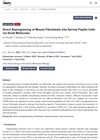Search
forLearn
5 / 18 resultslearn Epidermal Growth Factor
learn Overview
learn Stem Cell Factor
learn Osteopontin
signaling protein that, when suppressed, may grow hair by reducing inflammation and stem cell loss
Research
5 / 1000+ results
research Biological Characterization of Cultured Dermal Papilla Cells and Hair Follicle Regeneration In Vitro and In Vivo
Cultured dermal papilla cells can regenerate hair follicles and sustain hair growth.

research Induction of Dermal Fibroblasts into Dermal Papilla Cell-Like Cells in Hydrogel Microcapsules for Enhanced Hair Follicle Regeneration
Hydrogel microcapsules help create cells that boost hair growth.

research Self-Organizing Hair Peg-Like Structures From Dissociated Skin Progenitor Cells: New Insights for Human Hair Follicle Organoid Engineering and Turing Patterning in an Asymmetric Morphogenetic Field
Researchers created early-stage hair-like structures from skin cells, showing how these cells can self-organize, but more is needed for complete hair growth.

research Direct Reprogramming of Mouse Fibroblasts into Dermal Papilla Cells via Small Molecules
Scientists turned mouse skin cells into hair-inducing cells using chemicals, which could help treat hair loss.

research Dermal Papilla Cells: From Basic Research to Translational Applications
Dermal papilla cells can help regrow hair and are promising for hair loss treatments.
Community Join
5 / 1000+ results
community Compressed part of research of theory of androgenic/anabolitic balance. AGA h-responders analytic. Theory of physio-metabolitic method of anti AGA treatment
The treatment for androgenetic alopecia involves using finasteride and minoxidil with intense exercise and cold exposure to boost metabolism and reduce androgenic effects, potentially leading to hair regrowth. This approach may activate biological pathways for improved hair and overall health.

community If You Have DUPA, PLEASE READ THIS: Everyone Should Be Scalp Biopsied
Scalp biopsies are crucial for diagnosing hair loss conditions like Diffuse Unpatterned Alopecia (DUPA) and retrograde hair loss, as treatments like finasteride and dutasteride may not be effective if other conditions are present. Combining PPAR-GAMMA agonists with retinoids could improve treatments for conditions like Lichen Planopilaris.
community Unpopular Opinion: hair cloning kind of sucks as a potential future cure.
Hair cloning is seen as a distant and potentially less relevant solution for hair loss due to its high cost, invasiveness, and the advancement of other treatments like Minoxidil and finasteride. Many believe that by the time hair cloning becomes viable, other less invasive and more effective treatments will be available.
community CRISPR Is Curing People Right Now. Genetic Hair Loss is Next?
CRISPR shows promise for treating hair loss by targeting specific genes. Current treatments include Minoxidil and finasteride, but CRISPR could offer a more precise solution, though it is still expensive and in early stages.
community Summary of Procapil video by Haircafe
Procapil is marketed as a natural hair loss treatment but lacks strong evidence and is industry-biased. Minoxidil and Finasteride are the only FDA-approved treatments for androgenetic alopecia.